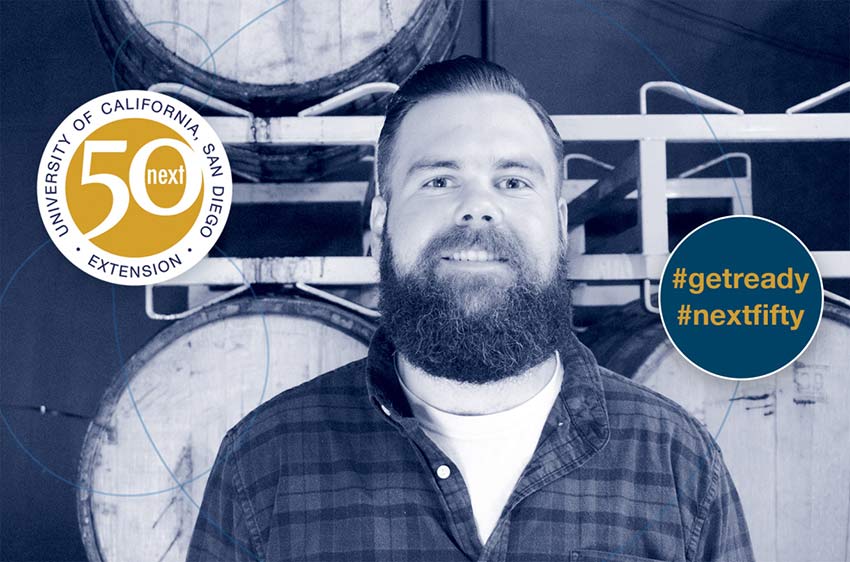22 November 2016
50 Voices of the Future: Mike Stevenson on the craft of brewing

In honor of UC San Diego Extension’s first 50 years, 50 Voices of the Future asks thought leaders about the trends, breakthroughs and social advances they foresee over the next 50 years.
Craft beer has been the fastest growing sector of alcoholic beverages in the nation, and with 130 breweries, San Diego County is considered a capital for beer connoisseurs. For many, brewing starts as an experiment in hopes of turning a passion into a quaffable product. A goal Mike Stevenson found himself achieving when he, and cofounder Ben Fairweather, opened Culver Beer Company in early 2015. Stevenson gained hands-on brewing experience through apprenticeships at brewpubs in Germany and Italy, received a Brewing certificate from UC San Diego Extension, and worked with Twisted Manzanita and White Labs where he gained valuable knowledge about yeast, fermentation and quality assurance.
(1) Why is the work you do important?
For one, craft beer has allowed for manufacturing jobs to exist in America again and people enjoy consuming local products. As an industry, we were fortunate to grow at the same time the farm-to-table movement really took off. People find value in knowing that what they are purchasing is helping support their local economy.
(2) What are the influential/exciting developments happening in your field now and why?
With the craft beer boom, there has been a dramatic shift affecting every aspect of the brewing industry. We’ve moved out of the Budweiser-dominated beer world where there was a limited choice of raw materials and only a few buyers, to now, where we are close to reaching 5,000 small independent breweries nationwide. The landscape has clearly changed. Barley farmers have started growing flavor rich varieties, which we have not seen before, maltsters are producing all sorts of new types of malted barley to brew with and hop growers keep coming up with crazy new strains to help fuel the IPA craze. Most bars, restaurants and pubs have increased their tap real estate to allow for a larger variety of beers and a lot of them strive to keep local craft beer on tap.
(3) What’s the next big thing?
Good question. I think the big bitter IPAs are slowing down in popularity and people are starting to explore other styles. Sour beers have grown into a nice niche market and some breweries in town only cater to this style of beer. Vanilla Cream Ales, Peanut Butter Stouts and other flavor filled beers have helped put their respective breweries on the map and they have seen awesome growth because of them. Our lagers and Belgian styles do just as well as our IPAs in our tap room and we plan on continuing to produce these styles as we try our hand at new ones. We need to find that one beer that will pay the bills and hit the market hard, and we have a few good contenders. I think rapid growth year over year will also begin to slow down as smaller guys come into the marketplace and push pressure upwards.
(4) How big an impact will your field play in shaping the future of the San Diego region and beyond?
San Diego has become an epicenter of brewing worldwide. We get plenty of out-of-town visitors in our taproom and their itineraries include the normal tourist activities followed by stopovers at local breweries. There are over 130 breweries in San Diego County, so almost anywhere you go you’re a short drive away from a brewery. I know plenty of brewers who started their brewing career in San Diego and have had wonderful opportunities to work around the country and world because they had a San Diego brewery on their resume. The recent Great American Beer Festival further solidified San Diego’s status as a craft beer hub, bringing home 18 of the 68 medals awarded to California breweries.
(5) Hop into your time machine … what does the future look like for this field in 50 years? How can individuals/companies get prepared for what’s next?
Beer has been around since civilization began. In 50 years, this craft beer phase will be another chapter in a brewing textbook. History has been repeating itself as of late with larger breweries starting to purchase smaller brands to add to their “craft portfolio.” I think we will see a lot more consolidation in the industry like we did in the 50s, 60s and 70s. However, I think we will see a large number of breweries remain small, catering to their local customer base. We are located in a business-dense area and serve as a pub for the local working-class people, who as they have always done, like to enjoy a beer after work. I think in the near future supply chains will get tighter and materials (hops) will be harder to source as the bigger guys lock down their contracts. The best advice I can give is to make good beer and get to know your regulars in the tasting room.
Interested in becoming a craft brewer? Learn more about UC San Diego Extension’s Brewing Certificate here.